
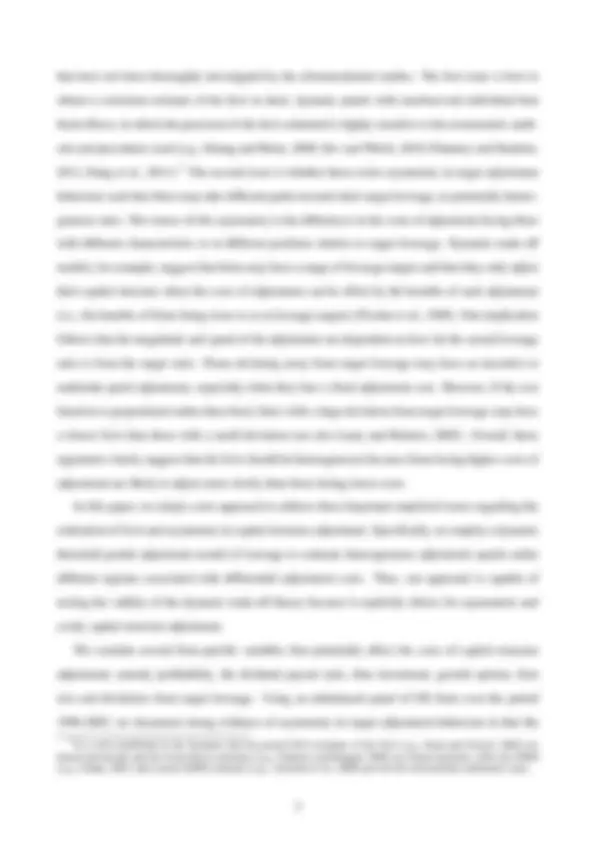
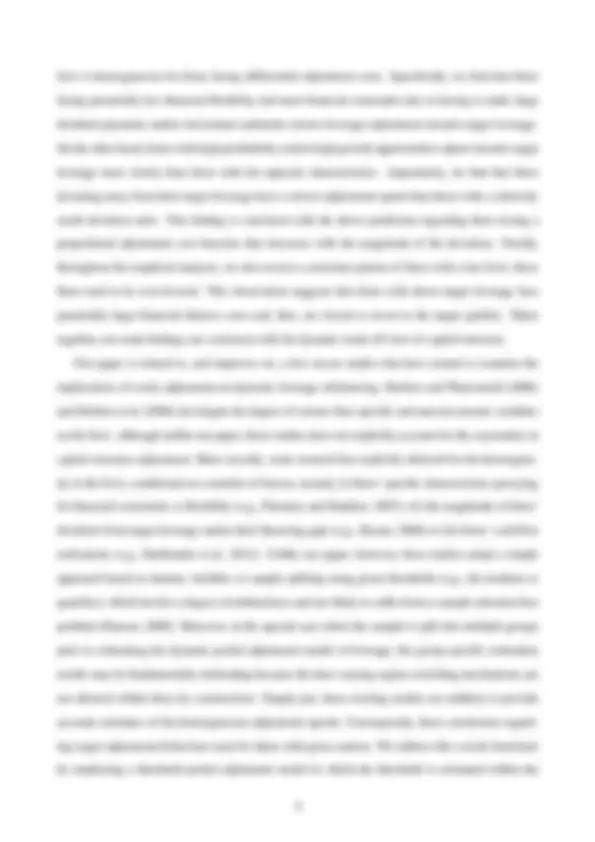
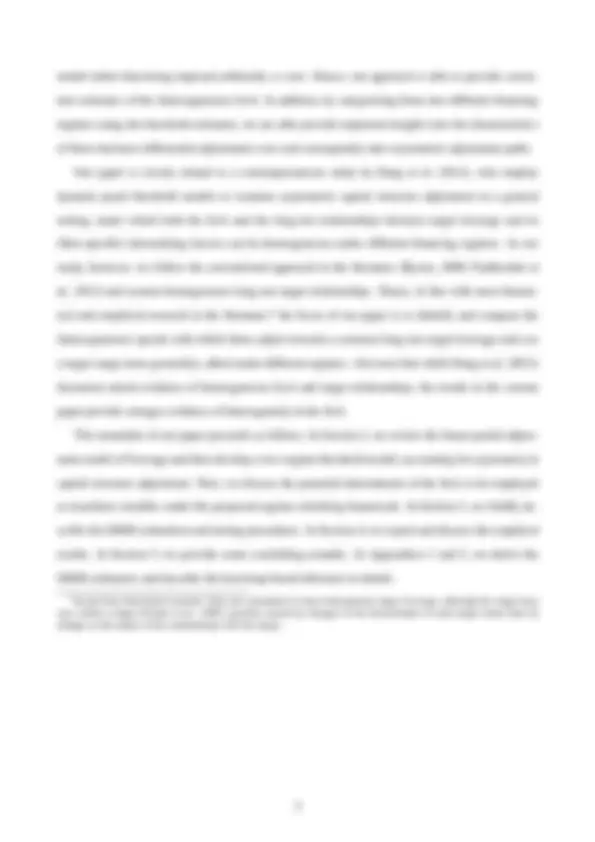
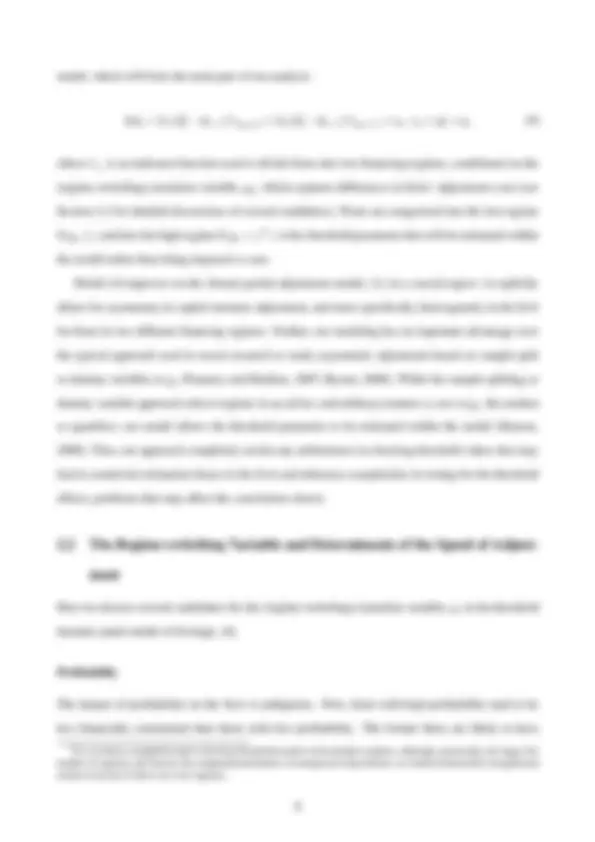
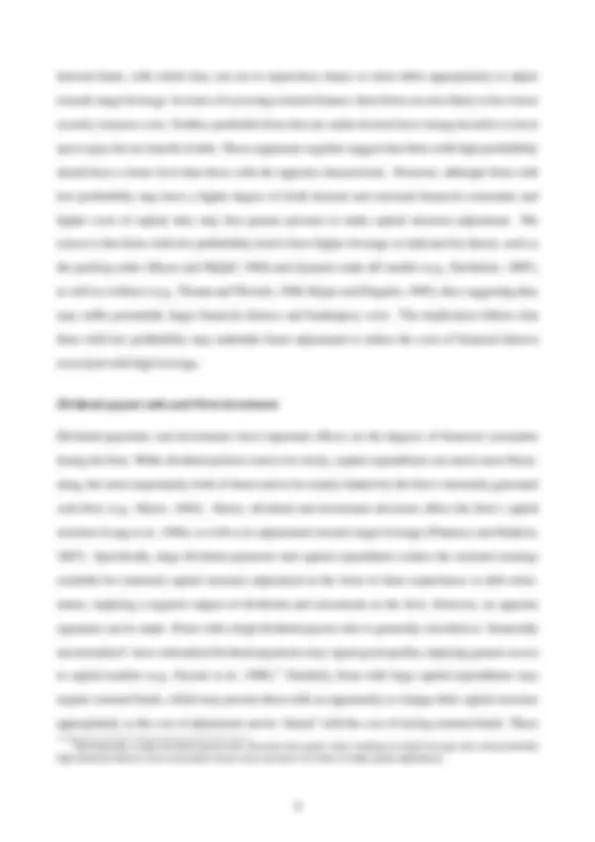
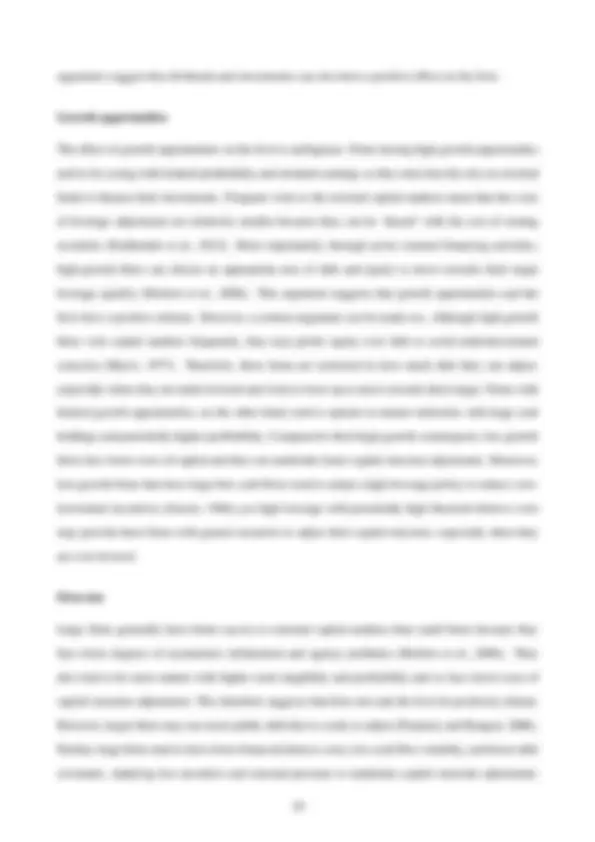
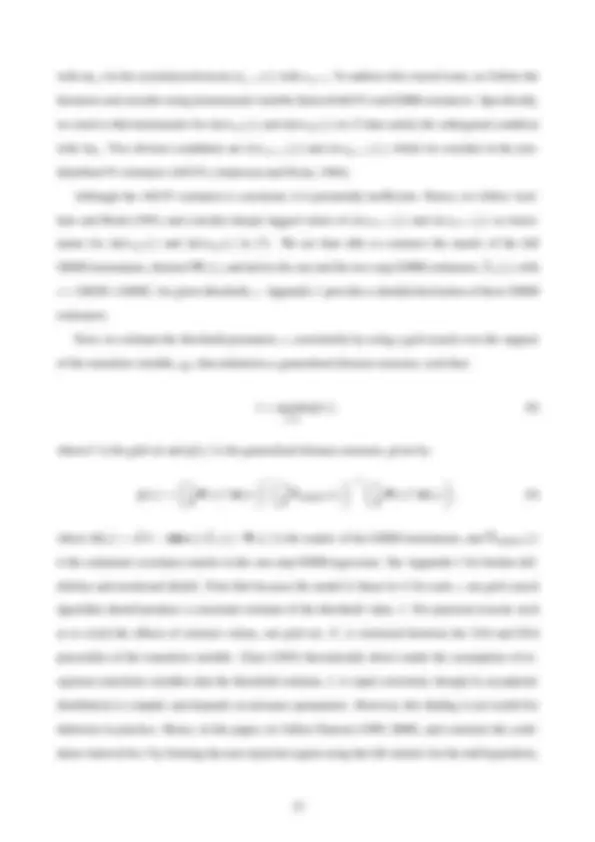
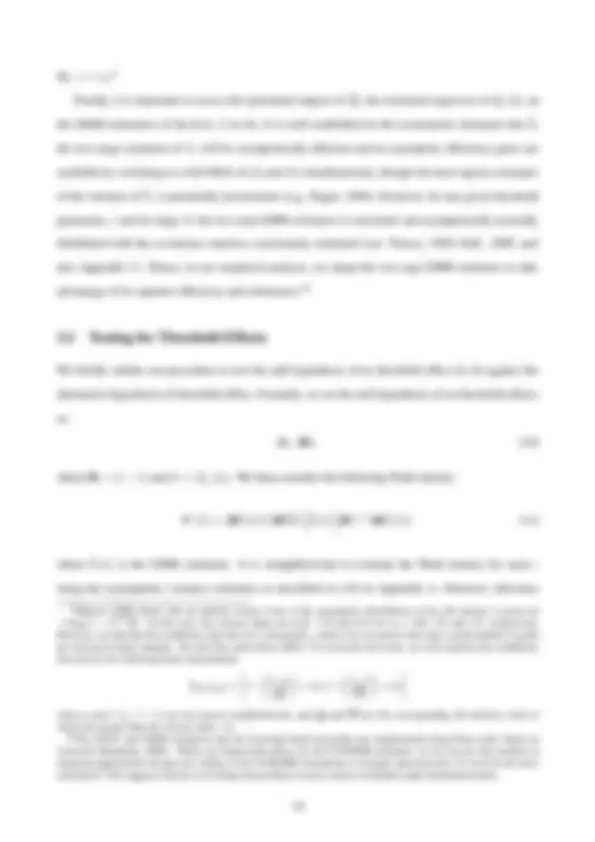
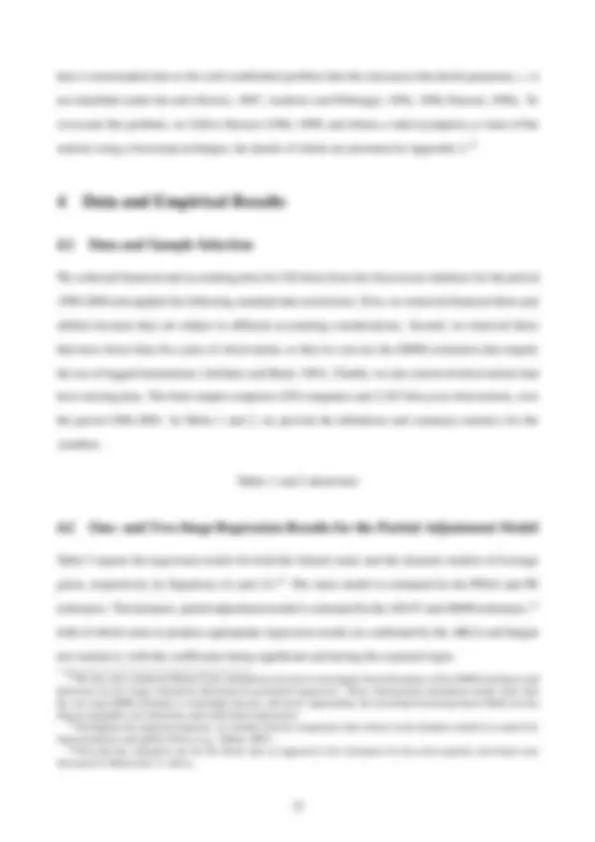
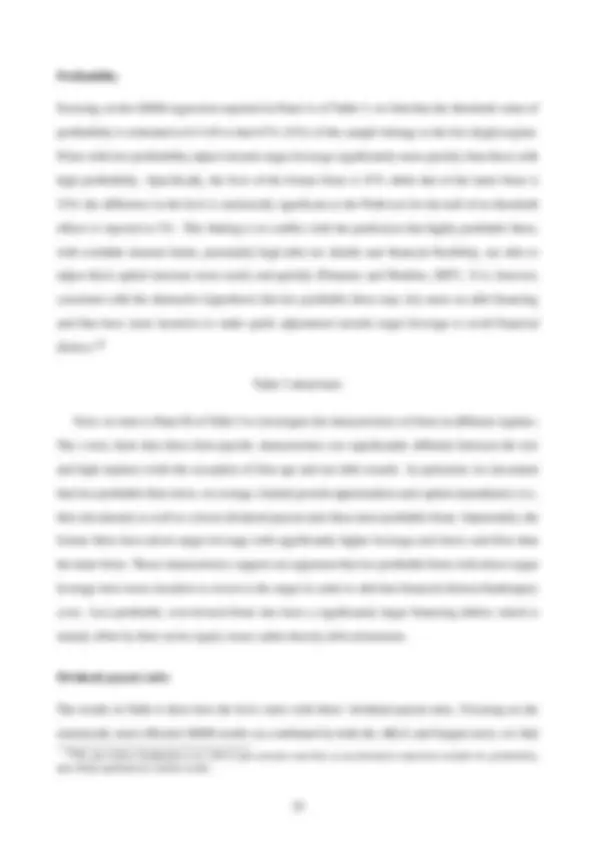
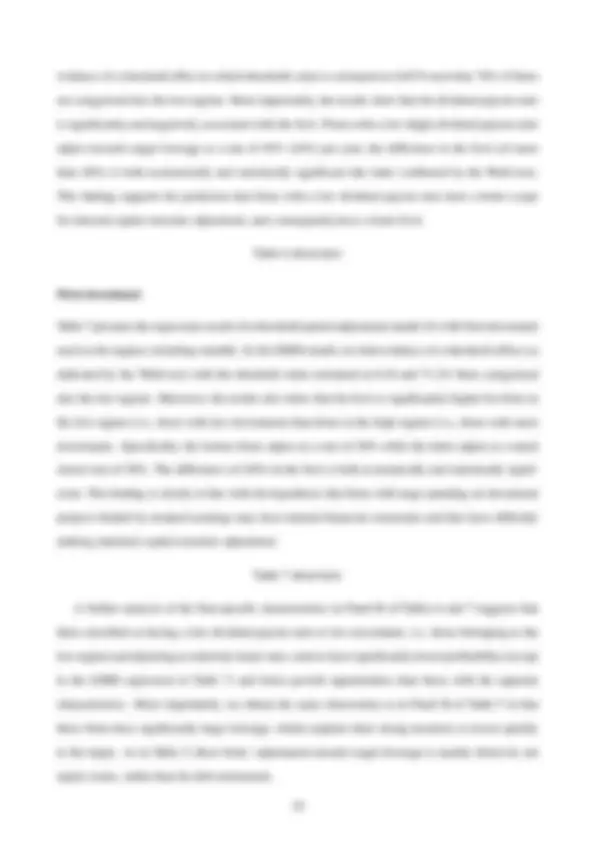
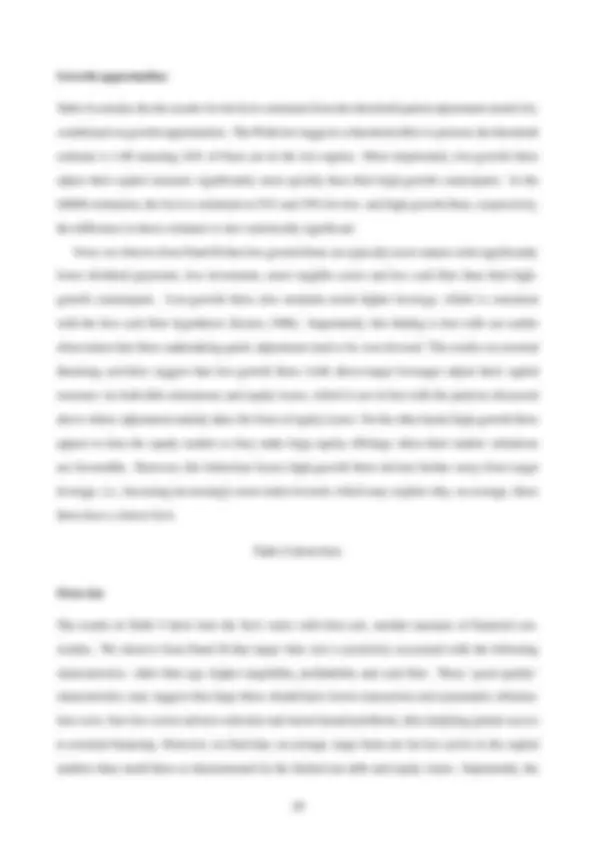
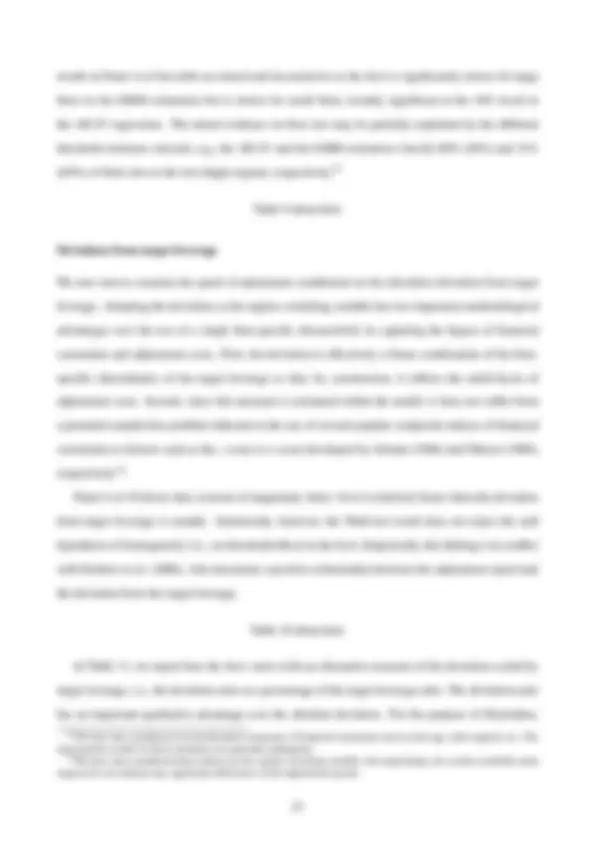
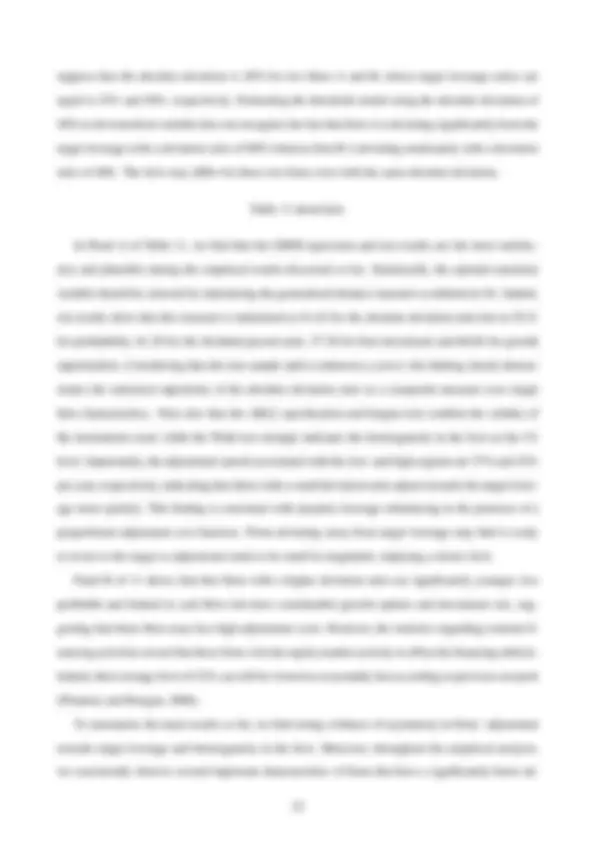
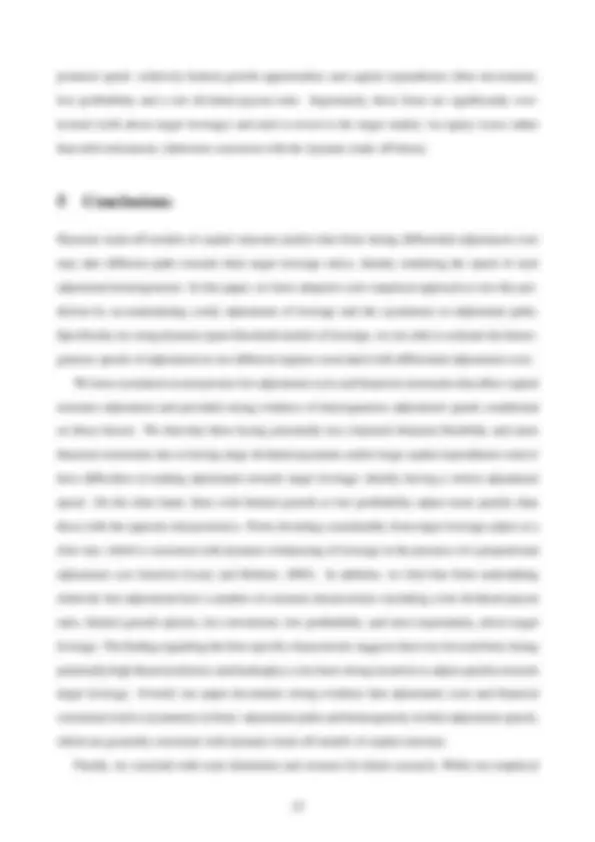

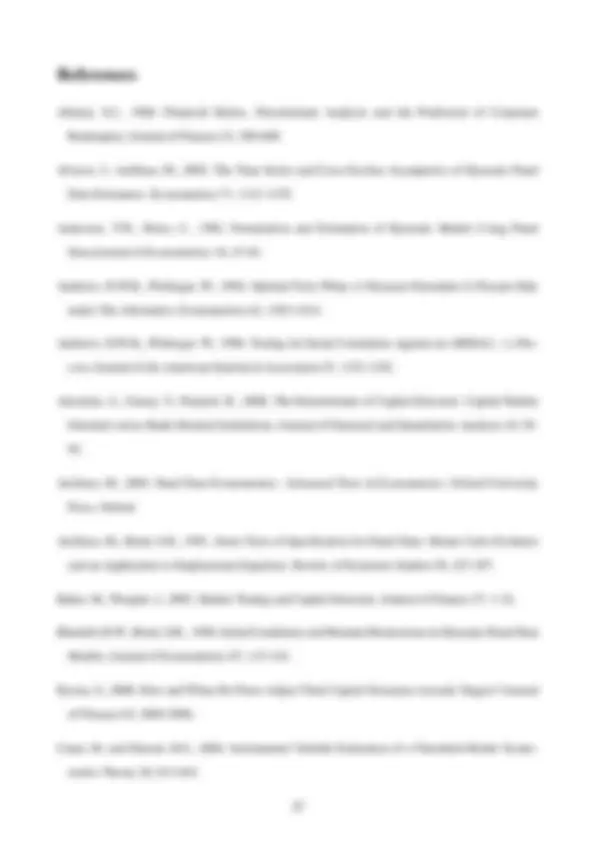
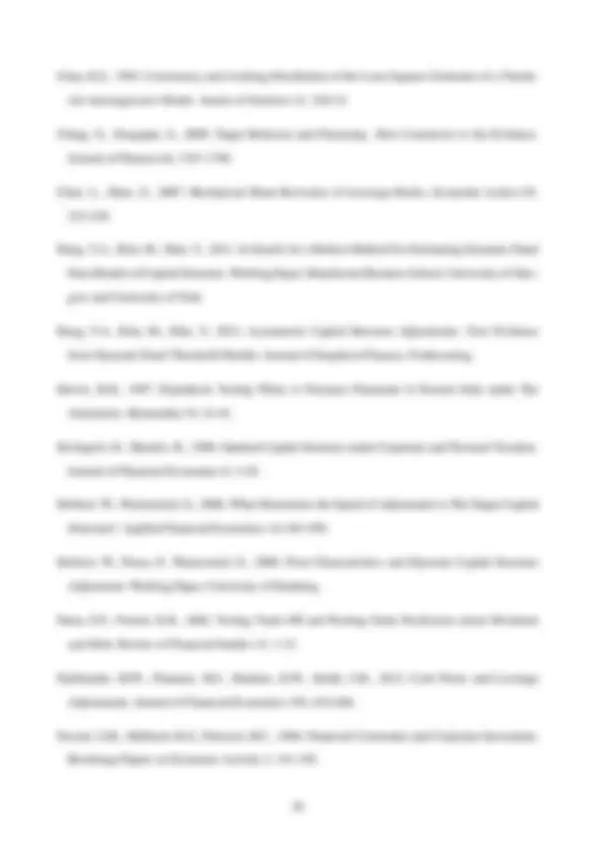
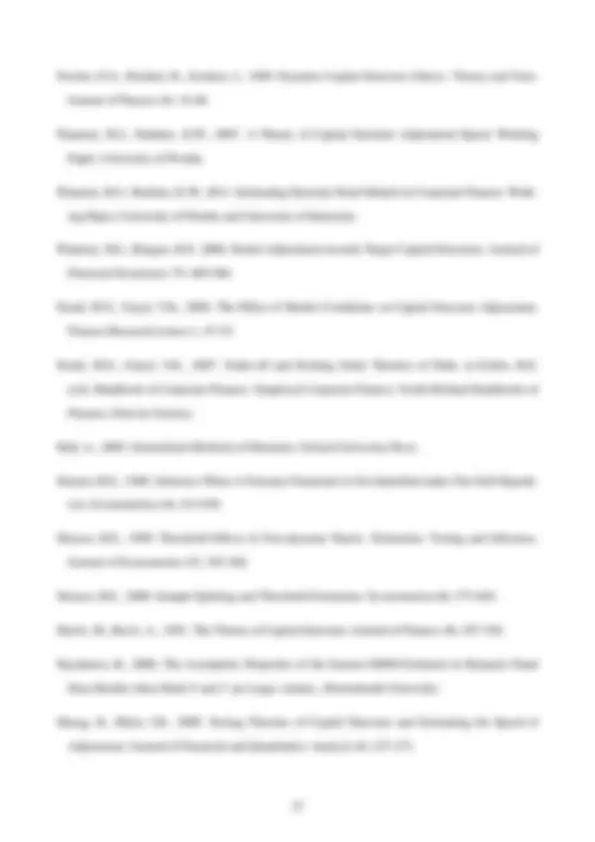
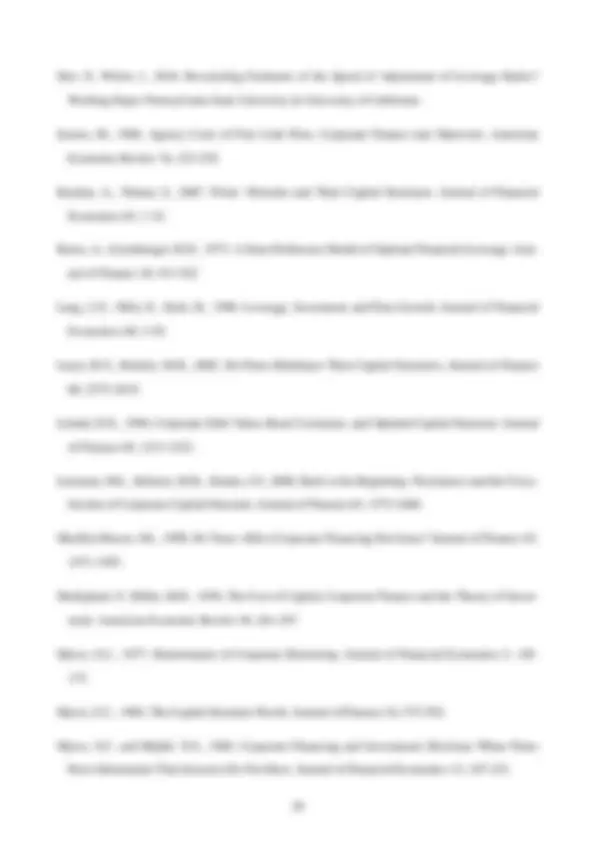
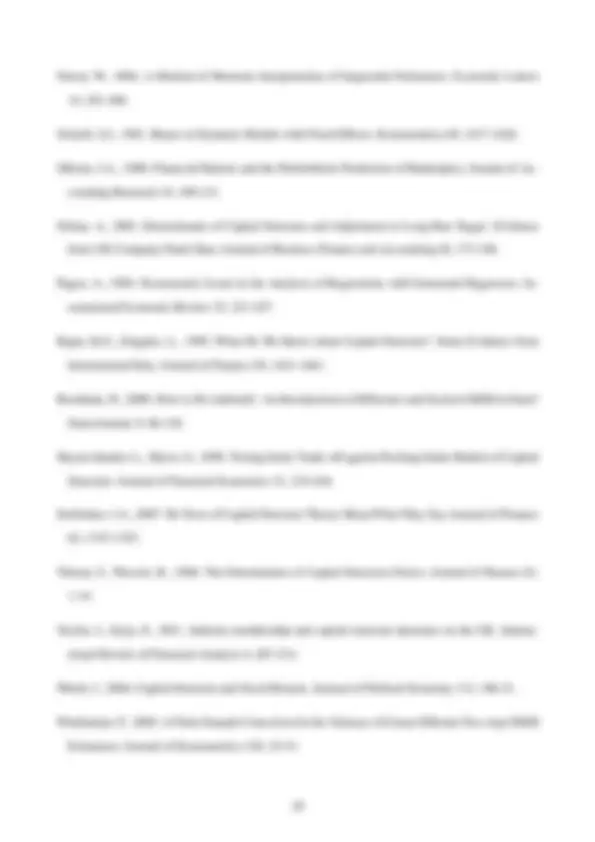

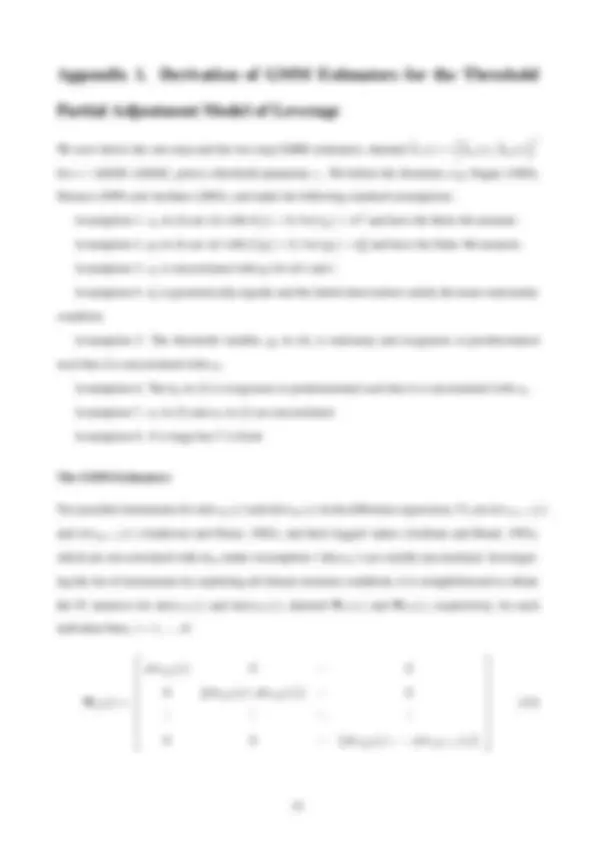
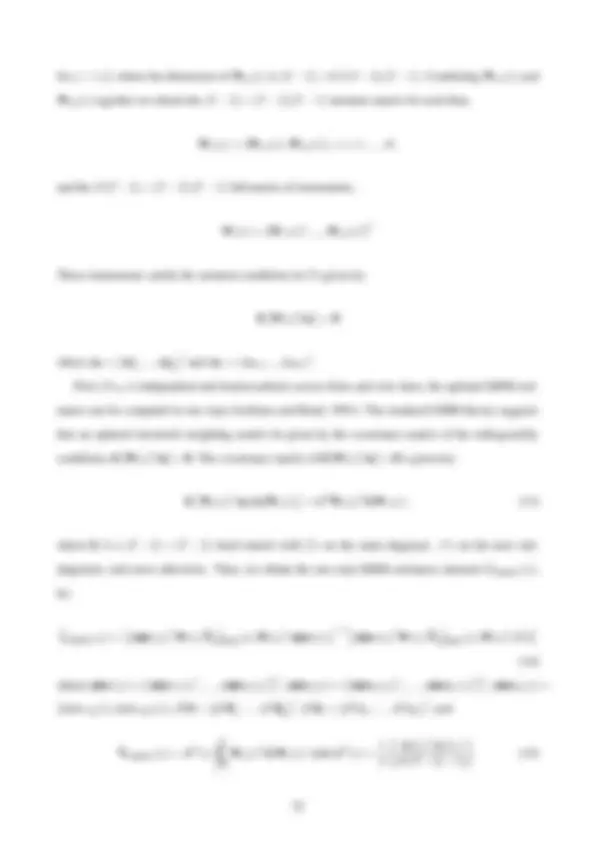
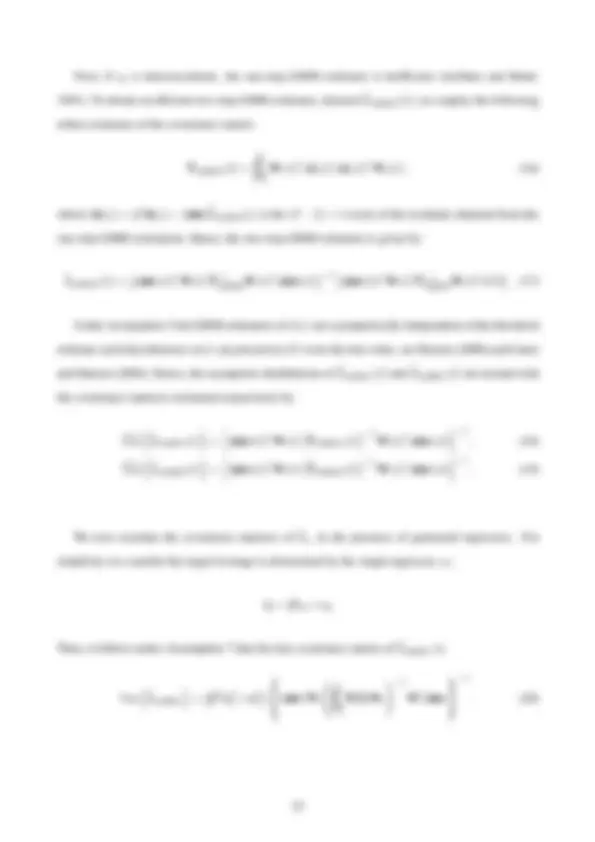
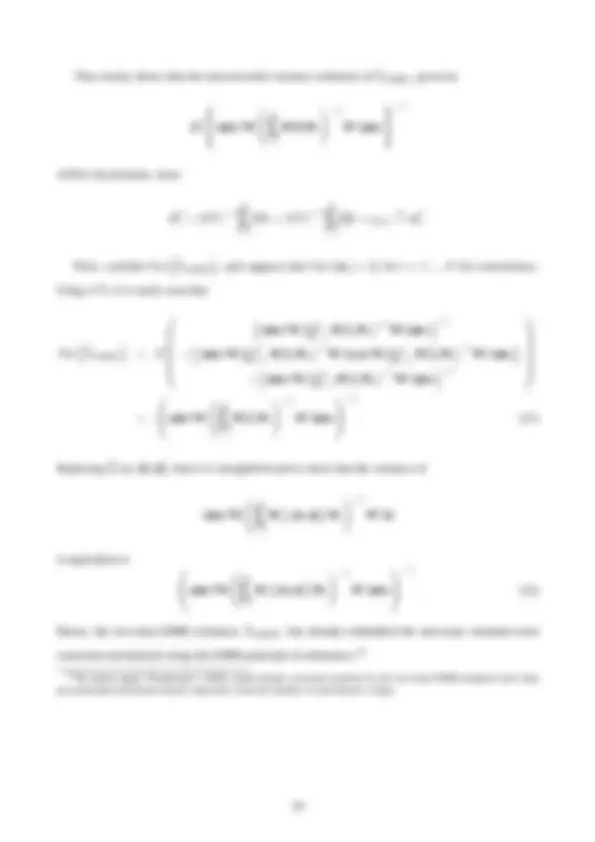
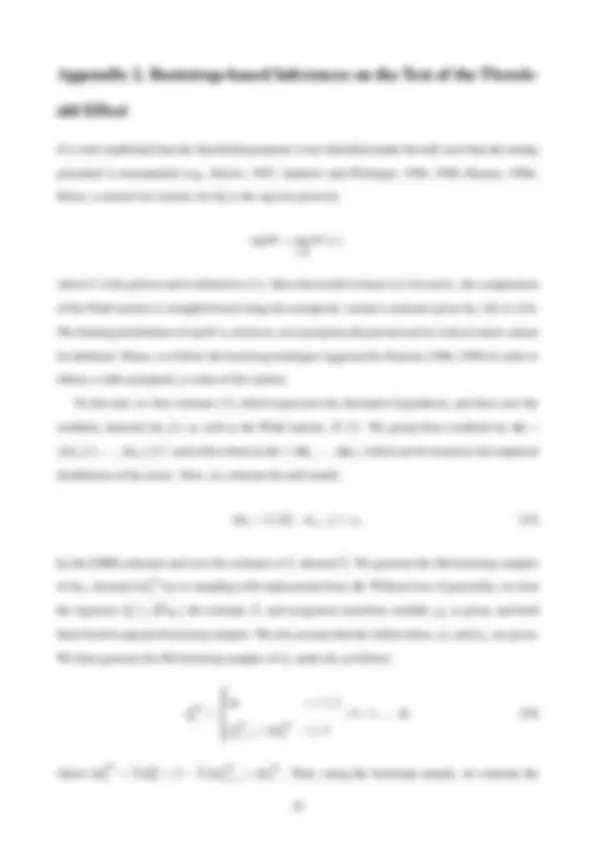
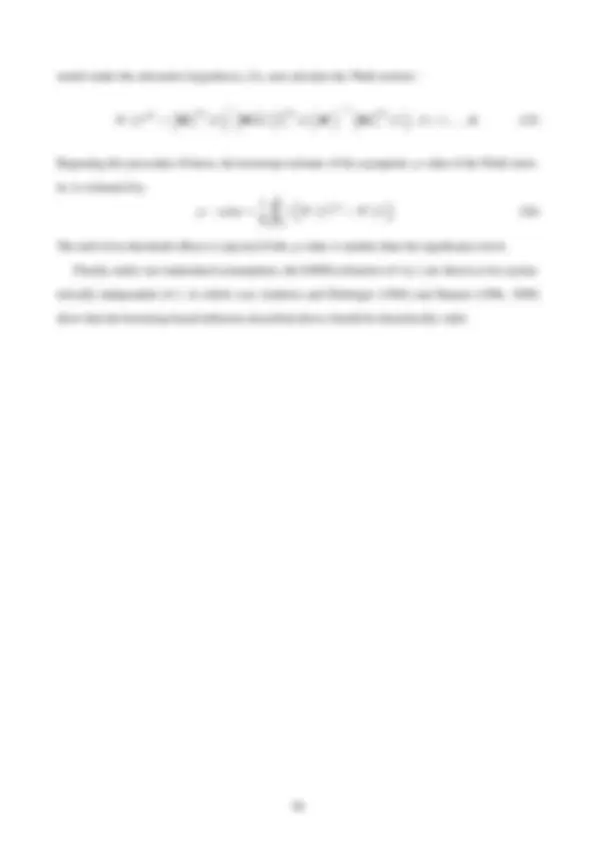
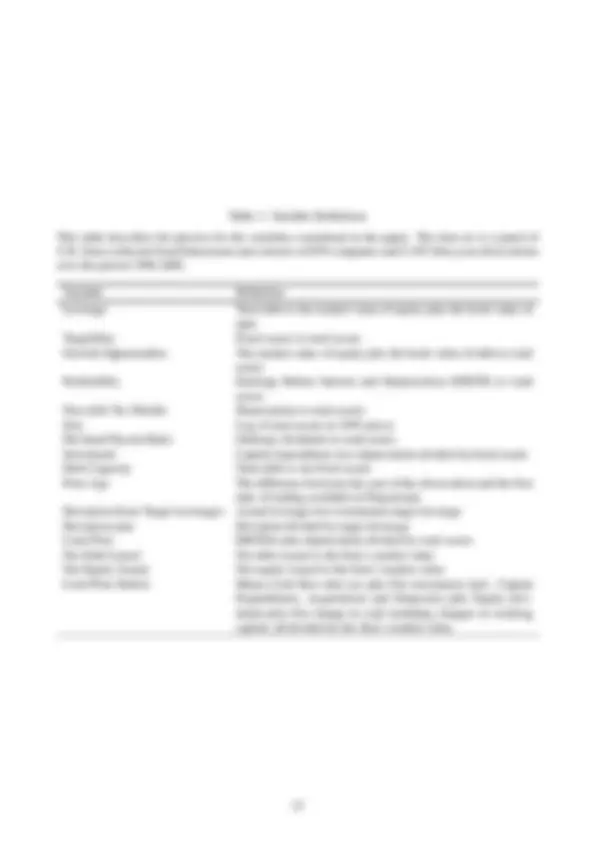
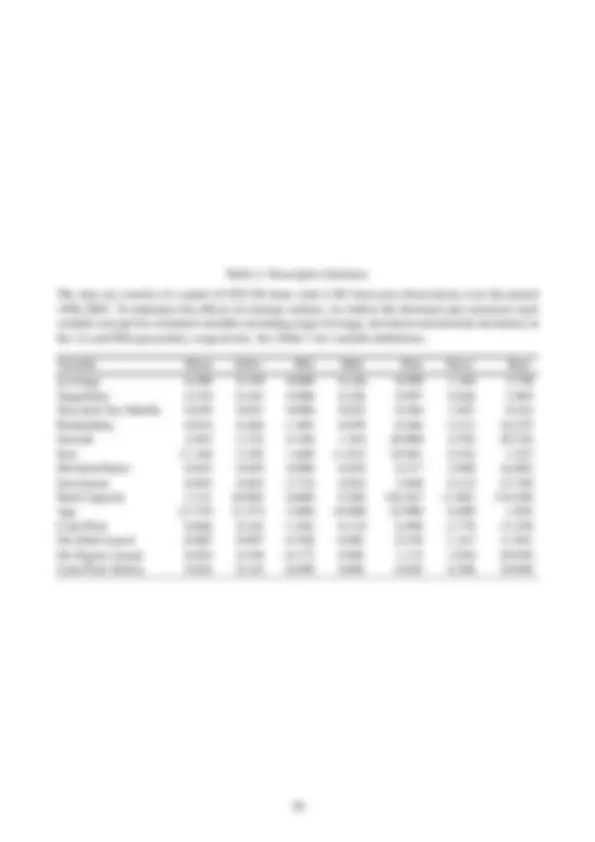
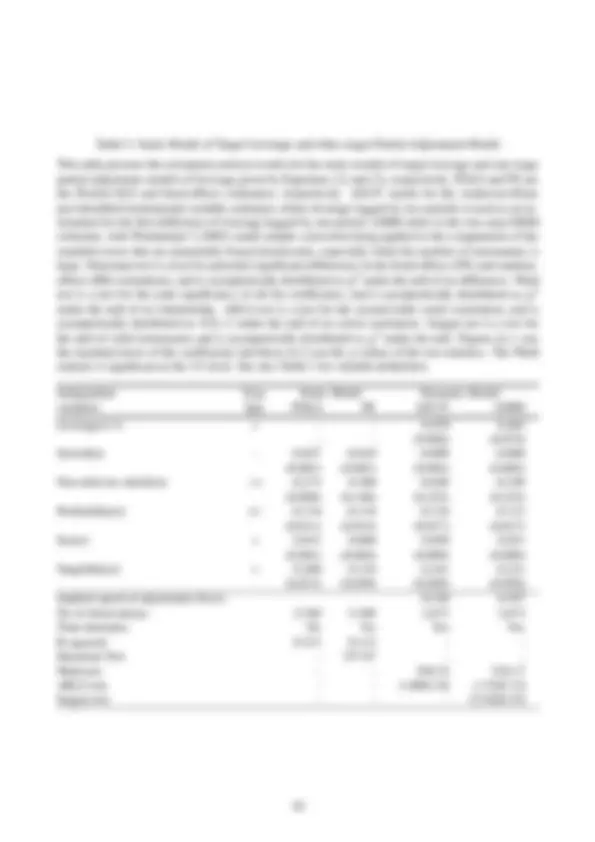
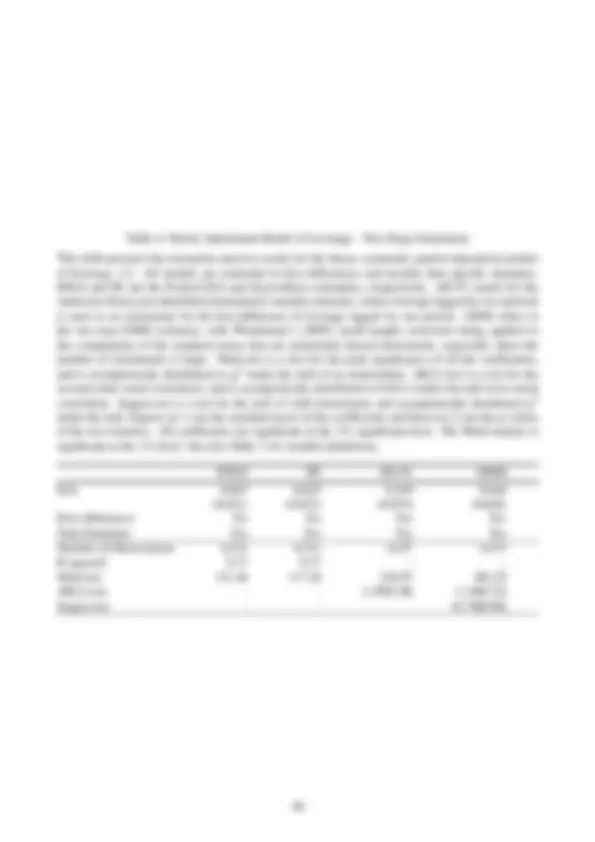
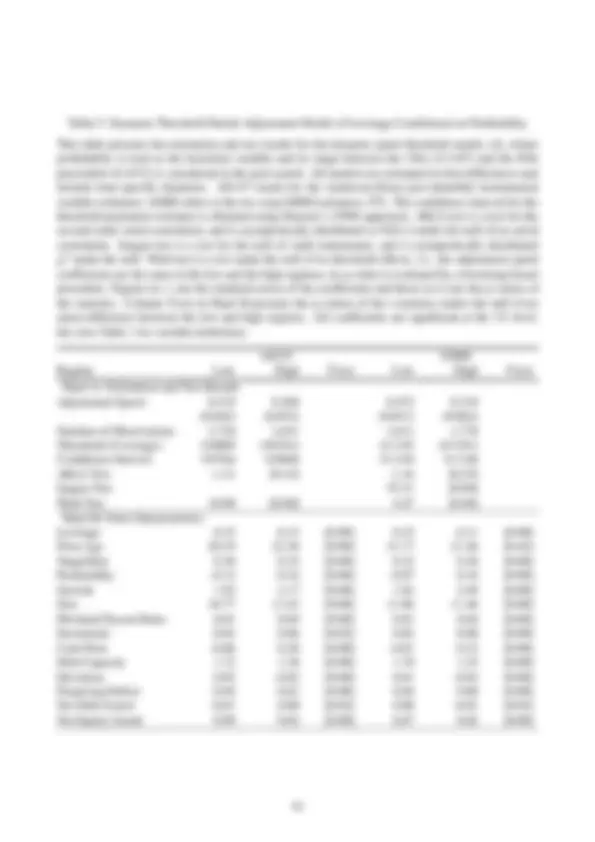
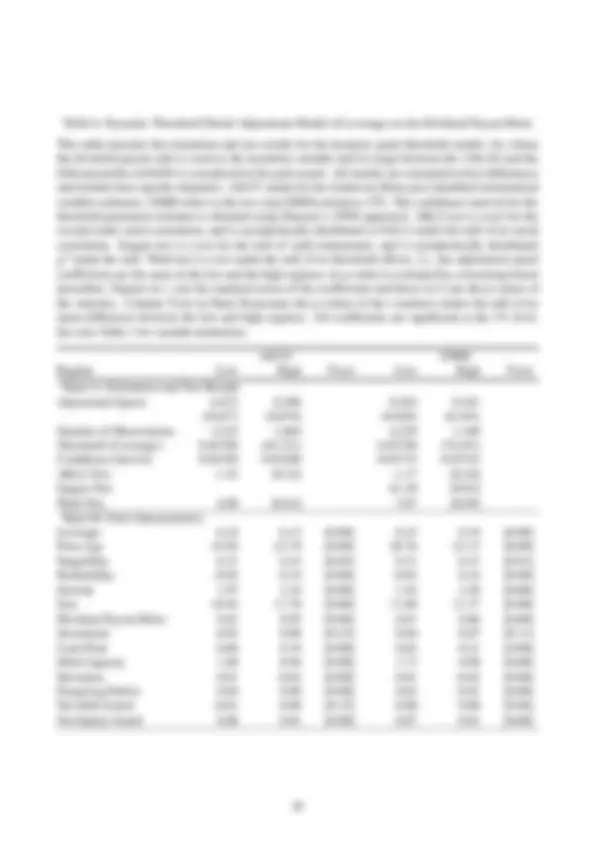
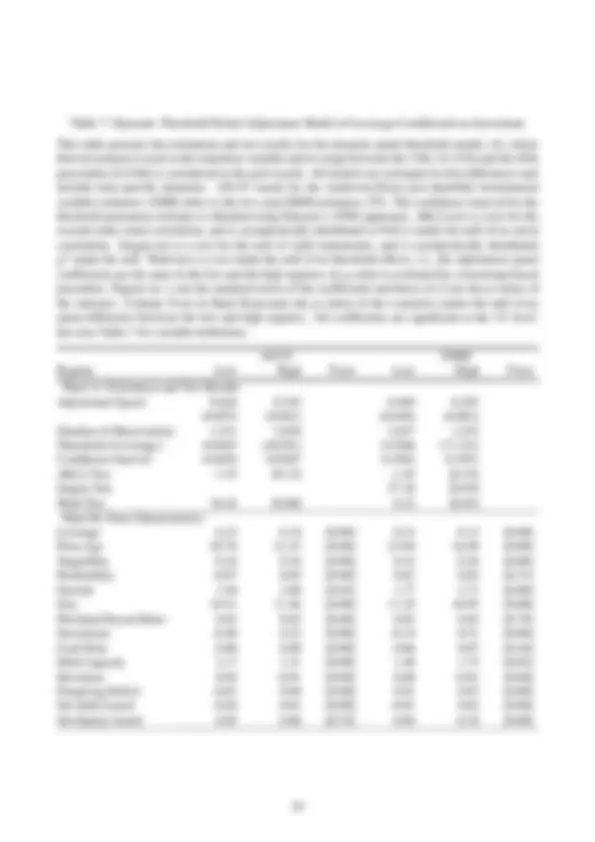
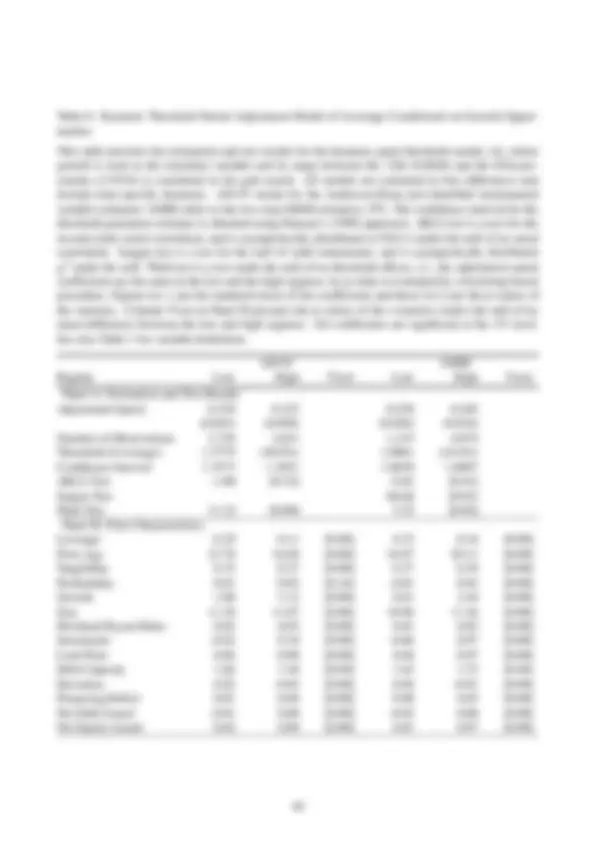

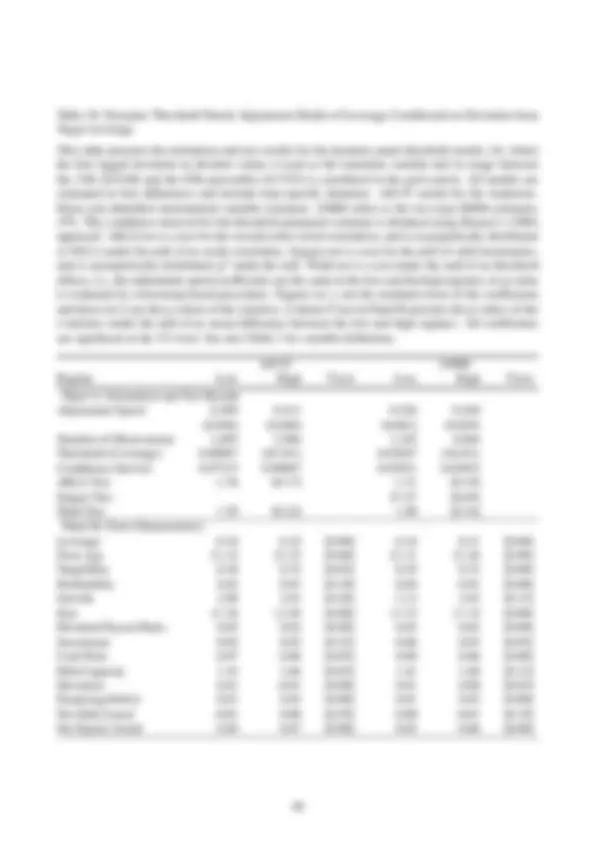
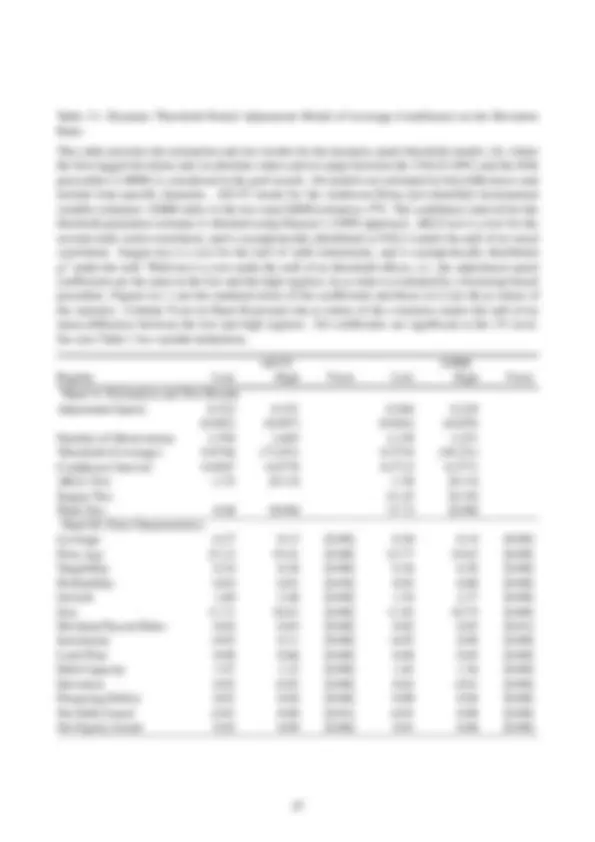


Study with the several resources on Docsity

Earn points by helping other students or get them with a premium plan


Prepare for your exams
Study with the several resources on Docsity

Earn points to download
Earn points by helping other students or get them with a premium plan
Community
Ask the community for help and clear up your study doubts
Discover the best universities in your country according to Docsity users
Free resources
Download our free guides on studying techniques, anxiety management strategies, and thesis advice from Docsity tutors
The findings of a study investigating the heterogeneity of adjustment speeds towards target leverage in firms, using a dynamic threshold partial adjustment model. The study reveals that firms with large dividend payments, large investments, high profitability, high growth opportunities, or significant deviations from target leverage exhibit slower adjustment speeds than those with opposite characteristics. The authors also provide insights into the characteristics of firms with differential adjustment costs and asymmetric adjustment paths.
What you will learn
Typology: Study notes
1 / 47

This page cannot be seen from the preview
Don't miss anything!








































Abstract We employ a new empirical approach based on dynamic threshold partial adjustment models to study the asymmetry in firms’ adjustment towards their target leverage ratios. We examine several factors proxying for differential costs of adjustment that may lead to the heterogeneity in the speed with which firms adjust their capital structure. Using an unbalanced panel of UK firms, we find that firms having high dividend payments, large investment, high profitability, high growth opportunities, or a large deviation from their target leverage have slower speeds of adjustment than those with the opposite characteristics. We further observe a consistent pattern that firms move towards target leverage quickly when they are over-levered, possibly to avoid the large financial distress associated with having above-target leverage. Taken together, our results provide strong empirical support for the dynamic trade-off theory.
JEL Classification: G32. Keywords: Capital Structure, Target Leverage, Dynamic Trade-off Theory, Partial Adjustment Model, Dynamic Panel Threshold Model.
∗We would like to thank seminar participants at Leeds University Business School (Economics and CASIF), Sung Kyun Kwan and Yonsei Universities, and the EFMA 2008 conference, and Richard Baillie, Michael Brennan, Charlie Cai, Yoosoon Chang, Ian Garrett, David Hillier, Kevin Keasy, Joon Park, Krishna Paudyal, Kevin Reilly, Kasbi Salma and Myung Seo for helpful comments and suggestions. Partial financial support from the ESRC (Grant No. RES-000-22-
1 Introduction
Since the irrelevance theorem by Modigliani and Miller (1958), three main views of corporate capital structure have been advanced in which the method of financing matters: the trade-off theory, the peck- ing order theory and the market-timing hypothesis. The trade-off theory, in both its static and dynamic forms, predicts an optimal capital structure that balances the costs (e.g., financial distress) against the benefits (e.g., debt interest tax shields) of debt financing; see, for example, Kraus and Litzenberger (1973) for a static trade-off model and Strebulaev (2007) for a dynamic model. Under this framework, corporate leverage is predicted to exhibit mean reversion as firms seek to adjust towards their target leverage. The pecking order theory, based on asymmetric information and adverse selection, suggests that firms’ observed mix of debt and equity simply reflects their cumulative financing decisions over time, whereby internal finance is preferred over external finance and debt is preferred over equity (Myers and Majluf, 1984; Myers, 1984). The market timing hypothesis posits that capital structure decisions are driven by market timing considerations in which firms attempt to time the equity mar- ket by issuing shares when market conditions are favourable (Baker and Wurgler, 2002).^1 Both the pecking-order theory and market timing hypothesis do not predict the existence of target leverage and firms’ adjustment towards such target. Hence, a large body of empirical research has tested the trade-off theory against these alternative views of capital structure by examining whether and how fast firms move towards target leverage; see Frank and Goyal (2007) for a comprehensive survey. Existing studies have so far used a linear partial adjustment model of leverage to estimate the speed of adjustment (hereafter SoA), i.e., the speed with which firms adjust their capital structure towards target leverage.^2 For example, Flannery and Rangan (2006) find that US firms adjust at a rate of more than 30% per year. Examining international data in the G-5 countries, Antoniou et al. (2008) also document reasonably fast adjustment speeds for firms in the US (32%), the UK (32%) and France (39%). Taken together, these empirical studies provide evidence of active target adjustment behaviour as predicted by the trade-off framework. Most recent research has begun to investigate two important issues in the study of the SoA, issues (^1) There is a growing literature examining the effect of capital market conditions on corporate capital structure. Welch (2004) observes that stock returns are a first-order and persistent determinant of (market) leverage. However, recent research calls into question the validity of this strand of research, e.g., Leary and Roberts (2005), Kayhan and Titman (2007), Strebulaev (2007), and Lemmon et al. (2008). 2 Alternative approaches include the use of a VAR framework or VAR co-integration techniques for aggregate or industry data (Frank and Goyal, 2004; Tucker and Stoja, 2011).
SoA is heterogeneous for firms facing differential adjustment costs. Specifically, we find that firms facing potentially less financial flexibility and more financial constraints due to having to make large dividend payments and/or investment undertake slower leverage adjustment towards target leverage. On the other hand, firms with high profitability and/or high growth opportunities adjust towards target leverage more slowly than those with the opposite characteristics. Importantly, we find that firms deviating away from their target leverage have a slower adjustment speed than those with a relatively small deviation ratio. This finding is consistent with the above prediction regarding firms facing a proportional adjustment cost function that increases with the magnitude of the deviation. Finally, throughout the empirical analysis, we also reveal a consistent pattern of firms with a fast SoA: these firms tend to be over-levered. This observation suggests that firms with above-target leverage face potentially large financial distress costs and, thus, are forced to revert to the target quickly. Taken together, our main findings are consistent with the dynamic trade-off view of capital structure. Our paper is related to, and improves on, a few recent studies that have started to examine the implications of costly adjustment on dynamic leverage rebalancing. Drobetz and Wanzenried (2006) and Drobetz et al. (2006) investigate the impact of various firm-specific and macroeconomic variables on the SoA , although unlike our paper, these studies does not explicitly account for the asymmetry in capital structure adjustment. More recently, some research has explicitly allowed for the heterogene- ity in the SoA, conditional on a number of factors, namely (i) firms’ specific characteristics proxying for financial constraints or flexibility (e.g., Flannery and Hankins, 2007), (ii) the magnitude of firms’ deviation from target leverage and/or their financing gaps (e.g., Byoun, 2008) or (iii) firms’ cash flow realisations (e.g., Faulkender et al., 2012). Unlike our paper, however, these studies adopt a simple approach based on dummy variables or sample splitting using given thresholds (e.g., the medians or quartiles), which involve a degree of arbitrariness and are likely to suffer from a sample selection bias problem (Hansen, 2000). Moreover, in the special case where the sample is split into multiple groups prior to estimating the dynamic partial adjustment model of leverage, the group-specific estimation results may be fundamentally misleading because the time-varying regime switching mechanisms are not allowed within firms by construction. Simply put, these existing studies are unlikely to provide accurate estimates of the heterogeneous adjustment speeds. Consequently, their conclusions regard- ing target adjustment behaviour must be taken with great caution. We address this crucial drawback by employing a threshold partial adjustment model in which the threshold is estimated within the
model rather than being imposed arbitrarily ex ante. Hence, our approach is able to provide consis- tent estimates of the (heterogeneous) SoA. In addition, by categorising firms into different financing regimes using the threshold estimates, we are able provide important insights into the characteristics of firms that have differential adjustment costs and consequently take asymmetric adjustment paths. Our paper is closely related to a contemporaneous study by Dang et al. (2012), who employ dynamic panel threshold models to examine asymmetric capital structure adjustment in a general setting, under which both the SoA and the long-run relationships between target leverage and its (firm-specific) determining factors can be heterogeneous under different financing regimes. In our study, however, we follow the conventional approach in the literature (Byoun, 2008; Faulkender et al., 2012) and assume homogeneous long-run target relationships. Hence, in line with most theoret- ical and empirical research in the literature,^4 the focus of our paper is to identify and compare the (heterogeneous) speeds with which firms adjust towards a common long-run target leverage ratio (or a target range more generally), albeit under different regimes. Also note that while Dang et al. (2012) document mixed evidence of heterogeneous SoA and target relationships, the results in the current paper provide stronger evidence of heterogeneity in the SoA. The remainder of our paper proceeds as follows. In Section 2, we review the linear partial adjust- ment model of leverage and then develop a two-regime threshold model, accounting for asymmetry in capital structure adjustment. Next, we discuss the potential determinants of the SoA to be employed as transition variables under the proposed regime-switching framework. In Section 3, we briefly de- scribe the GMM estimation and testing procedures. In Section 4, we report and discuss the empirical results. In Section 5, we provide some concluding remarks. In Appendices 1 and 2, we derive the GMM estimators and describe the bootstrap-based inference in details. (^4) In previous theoretical research, firms are considered to have homogenous target leverage, although the target may vary within a range (Fischer et al., 1989), possibly caused by changes in the determinants of such target rather than by changes in the nature of the relationships with the target.
leverage on the determinants in (2) and obtain the fitted values as proxies for target leverage, dˆ it∗ = β^ ˆ ′xit , where βˆ is the consistent estimate of β. Second, given the (estimated) target leverage, dˆ∗ it , we estimate the SoA, λ , in (1). Note that an alternative approach is to substitute (2) into (1), thus obtaining the following model that can be estimated in one stage (e.g., Ozkan, 2001; Flannery and Rangan, 2006): dit = φ dit− 1 + γ′xit + vit , (3)
where φ = 1 − λ and γ = λ β. In one-stage estimation, the SoA and target leverage relationships are estimated jointly such that λˆ = 1 − φˆ and βˆ = (^) 1- ˆγˆφ. In estimating the linear, partial adjustment model (1), we consider both the one- and two-stage estimation approaches.
Dynamic Threshold Partial Adjustment Model
Using the linear, partial adjustment model (1) assumes symmetry in firms’ capital structure adjust- ment such that the speed with which firms adjust towards target leverage is homogeneous. However, this assumption is not always valid because firms have different degrees of financial constraints or flexibility and thus do not adjust in the same manner. As mentioned, firms only adjust their capital structure when the costs of their adjustment are more than offset by the benefits of being close to target leverage (Fischer et al., 1989). It logically follows that firms with high levels of financial constraints face higher adjustment costs, resulting in potentially slower adjustment. In contrast, firms which en- joy good access to capital markets should have the capability to adjust their capital structure relatively quickly. In addition, firms may take different adjustment paths according to the position of their ac- tual leverage relative to the target leverage. Assuming a fixed adjustment cost function, firms should adjust their capital structure more frequently, at the lower or upper boundaries of the target leverage range. The larger the deviation from the target, the faster the speed of adjustment. However, when firms have a proportional adjustment cost function (Leary and Roberts, 2005), an opposite prediction can be reached. In this case, firms with actual leverage deviating away from the target leverage may find it costly to revert to the target, so that their adjustment is small in magnitude and takes place more slowly. These arguments simply suggest that firms’ adjustment speed should be different, according to their degrees of financial constraints, or their position relative to target leverage. To account for such asymmetry in capital structure adjustment, we employ the following threshold partial adjustment
model, which will form the main part of our analysis:
∆dit = λ 1 (d∗ it − dit− 1 ) (^1) (qit ≤c) + λ 2 (d it∗ − dit− 1 ) (^1) (qit >c) + vit , vit = μi + eit (4)
where 1(·) is an indicator function used to divide firms into two financing regimes, conditional on the (regime-switching) transition variable, qit , which captures differences in firms’ adjustment costs (see Section 2.2 for detailed discussions of several candidates). Firms are categorised into the low regime if qit ≤ c and into the high regime if qit > c.^6 c is the threshold parameter that will be estimated within the model rather than being imposed ex ante. Model (4) improves on the (linear) partial adjustment model, (1), in a crucial aspect: it explicitly allows for asymmetry in capital structure adjustment, and more specifically, heterogeneity in the SoA for firms in two different financing regimes. Further, our modeling has an important advantage over the typical approach used in recent research to study asymmetric adjustment based on sample-split or dummy variables (e.g., Flannery and Hankins, 2007; Byoun, 2008). While the sample-splitting or dummy variable approach selects regimes in an ad hoc and arbitrary manner ex ante (e.g., the median or quartiles), our model allows the threshold parameter to be estimated within the model (Hansen, 2000). Thus, our approach completely avoids any arbitrariness in choosing threshold values that may lead to nontrivial estimation biases in the SoA and inference complexities in testing for the threshold effects, problems that may affect the conclusions drawn.
Here we discuss several candidates for the (regime-switching) transition variable, q, in the threshold dynamic panel model of leverage, (4).
Profitability
The impact of profitability on the SoA is ambiguous. First, firms with high profitability tend to be less financially constrained than those with low profitability. The former firms are likely to have (^6) It is in theory straightforward to develop threshold models with multiple regimes, although, practically, the larger the number of regimes, the heavier the computational burden. In unreported experiments, we found (statistically) insignificant results in favour of three over two regimes.
arguments suggest that dividends and investments can also have a positive effect on the SoA.
Growth opportunities
The effect of growth opportunities on the SoA is ambiguous. Firms having high growth opportunities tend to be young with limited profitability and retained earnings so they must heavily rely on external funds to finance their investments. Frequent visits to the external capital markets mean that the costs of leverage adjustment are relatively smaller because they can be ’shared’ with the cost of issuing securities (Faulkender et al., 2012). More importantly, through active external financing activities, high-growth firms can choose an appropriate mix of debt and equity to move towards their target leverage quickly (Drobetz et al., 2006). This argument suggests that growth opportunities and the SoA have a positive relation. However, a counter-argument can be made too. Although high-growth firms visit capital markets frequently, they may prefer equity over debt to avoid underinvestment concerns (Myers, 1977). Therefore, these firms are restricted in how much debt they can adjust, especially when they are under-levered and wish to lever up to move towards their target. Firms with limited growth opportunities, on the other hand, tend to operate in mature industries with large cash holdings and potentially higher profitability. Compared to their high-growth counterparts, low-growth firms face lower costs of capital and thus can undertake faster capital structure adjustment. Moreover, low-growth firms that have large free cash flows tend to adopt a high leverage policy to reduce over- investment incentives (Jensen, 1986); yet high leverage with potentially high financial distress costs may provide these firms with greater incentive to adjust their capital structure, especially when they are over-levered.
Firm size
Large firms generally have better access to external capital markets than small firms because they face lower degrees of asymmetric information and agency problems (Drobetz et al., 2006). They also tend to be more mature with higher asset tangibility and profitability and so face lower costs of capital structure adjustment. This therefore suggests that firm size and the SoA be positively related. However, larger firms may use more public debt that is costly to adjust (Flannery and Rangan, 2006). Further, large firms tend to have lower financial distress costs, less cash flow volatility, and fewer debt covenants, implying less incentive and external pressure to undertake capital structure adjustment.
The prediction follows that large firms have a slower SoA than small firms.
Deviations from target leverage
The dynamic trade-off theory suggests that capital structure adjustment does not take place frequently because firms allow leverage to deviate from the target as long as adjustment costs (transactional and contractual costs) outweigh the benefits of reverting to the target (Fischer et al., 1989; Leland, 1994). If adjustment costs are mainly fixed, the larger the deviation from target leverage, the more likely firms will undertake adjustment towards the target. There will be some lower or upper bounds where the benefits of achieving the target leverage outweigh the fixed costs of adjustment. At these restructuring points, capital structure adjustment takes place more quickly, implying a positive relationship between the absolute deviation from the target and the SoA. However, if adjustment costs are an increasing function of the target leverage deviation, i.e., a proportional cost function (Leary and Roberts, 2005), we may reach a conflicting prediction. Firms deviating away from target leverage may find it costly to revert to such target, meaning any adjustment tends to be small in magnitude. Alternatively, when adjustment costs become prohibitively high, firms tend to avoid external adjustment in the form of security issues or repurchases (or retirements), and rely more on internal adjustment, which is limited in scope and magnitude (Drobetz et al., 2006). Further, firms tend to refrain from using all internal funds for adjustment purposes because they wish to preserve their financial flexibility to take future investment opportunities. All these arguments imply a negative relationship between the magnitude of target leverage deviation and the SoA.
3 Methods
In this section, we combine three branches of literature, namely (linear) dynamic panel data mod- els (Alvarez and Arellano, 2003), threshold models in nonlinear time series analysis (Chan, 1993; Hansen, 2000) with threshold models in static panels (Hansen, 1999) to develop estimation and test- ing procedures for the threshold dynamic panel data model, (4). Specifically, we first develop a method to consistently estimate the adjustment speeds and the threshold parameter in (4). Next, we propose a bootstrap-based testing procedure for the threshold effect and the heterogeneity in the SoA.
with ∆eit via the correlation between di,t− 1 (c) with ei,t− 1. To address this crucial issue, we follow the literature and consider using instrumental variable (henceforth IV) and GMM estimators. Specifically, we need to find instruments for ∆dev 1 it (c) and ∆dev 2 it (c) in (7) that satisfy the orthogonal condition with ∆eit. Two obvious candidates are dev 1 i,t− 1 (c) and dev 2 i,t− 1 (c), which we consider in the just- identified IV estimator (AH-IV) (Anderson and Hsiao, 1982). Although the AH-IV estimator is consistent, it is potentially inefficient. Hence, we follow Arel- lano and Bond (1991) and consider deeper lagged values of dev 1 i,t− 1 (c) and dev 2 i,t− 1 (c) as instru- ments for ∆dev 1 it (c) and ∆dev 2 it (c) in (7). We are then able to construct the matrix of the full GMM instruments, denoted W (c), and derive the one and the two-step GMM estimators, λˆ (^) s (c), with s = GMM 1 , GMM 2 , for given threshold, c. Appendix 1 provides a detailed derivation of these GMM estimators. Next, we estimate the threshold parameter, c, consistently by using a grid search over the support of the transition variable, qit , that minimises a generalised distance measure, such that:
cˆ = argmin c∈C Q (c). (8)
where C is the grid set and Q (c) is the generalised distance measure, given by:
Q (c) =
N W^ (c)
′ (^) ∆eˆ (c)
N VˆGMM^1 (c)
N W^ (c)
′ (^) ∆eˆ (c)
where ∆ˆe (c) = ∆^2 d − ∆dev (c) λˆ (^) s (c). W (c) is the matrix of the GMM instruments, and VˆGMM 1 (c) is the estimated covariance matrix in the one-step GMM regression. See Appendix 1 for further def- initions and notational details. Note that because the model is linear in λ for each c, our grid search algorithm should produce a consistent estimate of the threshold value, ˆc. For practical reasons such as to avoid the effects of extreme values, our grid set, C , is restricted between the 15th and 85th percentiles of the transition variable. Chan (1993) theoretically shows under the assumption of ex- ogenous transition variables that the threshold estimate, ˆc, is super-consistent, though its asymptotic distribution is complex and depends on nuisance parameters. However, this finding is not useful for inference in practice. Hence, in this paper, we follow Hansen (1999, 2000), and construct the confi- dence interval for ˆc by forming the non-rejection region using the LR statistic for the null hypothesis,
H 0 : c = c 0.^9 Finally, it is important to assess the (potential) impact of ˆd∗ it , the estimated regressor of d∗ it (2), on the GMM estimators of the SoA, λ in (6). It is well-established in the econometric literature that λˆ , the two-stage estimator of λ , will be asymptotically efficient and no asymptotic efficiency gains are available by switching to a full MLE of (2) and (5) simultaneously, though the least-square estimator of the variance of λˆ , is potentially inconsistent (e.g., Pagan, 1984). However, for any given threshold parameter, c and for large N, the two-step GMM estimator is consistent and asymptotically normally distributed with the covariance matrices consistently estimated (see Newey, 1984; Hall , 2005, and also Appendix 1). Hence, in our empirical analysis, we adopt the two-step GMM estimator to take advantage of its superior efficiency and robustness.^10
We briefly outline our procedure to test the null hypothesis of no threshold effect in (4) against the alternative hypothesis of threshold effect. Formally, we set the null hypothesis of no threshold effects as: H 0 : Rλ , (10)
where R = ( 1 , − 1 ) and λ = (λ 1 , λ 2 ). We then consider the following Wald statistic:
W ( cˆ) = (R λˆ ( cˆ))′(RVar̂
λ ( cˆ)
R′)−^1 (R λˆ ( cˆ)). (11)
where λˆ ( cˆ) is the GMM estimator. It is straightforward to evaluate the Wald statistic for each c using the (asymptotic) variance estimates as described in (19) in Appendix A. However, inference (^9) Hansen (1999) shows that an analytic inverse form of the asymptotic distribution of the LR statistic is given by −2 log ( 1 − √ 1 − α). In this case, the critical values are 6.53, 7.35 and 10.5 for α = 10%, 5% and 1%, respectively. However, we find that the confidence intervals for ˆc, denoted Cα , tends to be too narrow that only a small number of grids are selected in finite samples. See also Seo and Linton (2007). To overcome this issue, we will construct the confidence intervals by the following linear interpolation: [ (^) cˆinf, cˆsup ] (^) =^ [c ˆ −^ (^ cˆ − c LR
) × crit, cˆ +
( (^) c¯ − cˆ LR
) × crit
]
where c and ¯c (c < cˆ < c¯) are two nearest neighborhoods, and LR and LR are the corresponding LR statistics, both of which are greater than the critical value, 10 crit. The AH-IV and GMM estimators and the bootstrap-based procedure are implemented using Stata codes based on xtabond2 (Roodman, 2009). While our framework allows for the SYSGMM estimator, we do not use this method in empirical applications because the validity of the SYSGMM instruments is strongly rejected at the 1% level for all cases considered. This suggests that the over-fitting bias problem is more serious in dynamic panel threshold models.
Table 3 about here The results show that growth opportunities and target leverage are negatively related, which is in line with the underinvestment hypothesis that firms with high growth options avoid using leverage to alleviate the ’debt overhang’ problem (Myers, 1977). Next, profitability has a significantly negative effect on target leverage, which is consistent with both the pecking order theory (Myers and Majluf, 1984; Myers, 1984) and the dynamic trade-off model (Strebulaev, 2007), as well as with previous empirical evidence (Titman and Wessels, 1988; Rajan and Zingales, 1995). The relation between tangibility and target leverage is significantly positive, which supports the argument that tangible assets can be used as collateral to avoid the asset substitution problem and reduce the agency costs of debt (e.g., Frank and Goyal, 2007). Non-debt tax shields have a significantly negative effect on target leverage (except in the FE model where a positive effect is found),^14 in line with the hypothesis that non-debt tax shields can substitute for debt tax shields (DeAngelo and Masulis, 1980). Firm size and target leverage are positively related, which is consistent with the prediction that large firms face generally lower bankruptcy, agency and transaction costs than small firms (Frank and Goyal, 2007). Most importantly, we find that the (implied) SoA is estimated at 53% and 60%, respectively, by the AH-IV and GMM estimators, implying that 53-60% of firms’ deviations from target leverage are closed within a year. These results show that UK firms on average undertake reasonably fast adjustment, which is consistent with previous UK evidence (e.g., Ozkan, 2001) and is in line with the trade-off theory’s prediction.^15 As commented above, the difference in the estimates suggests that the magnitude of the SoA is sensitive to the estimator used. To further examine the robustness of the one-stage estimation results, we estimate the partial adjustment model of leverage using the two-stage procedure based on (1) and (2). To derive the esti- mated target leverage from (2) in the first stage, we employ the FE estimates reported in the column 2 of Table 3.^16 In Table 4, we report the results obtained by using four alternative estimators, includ- ing two traditional, yet biased methods for dynamic panels (i.e., POLS and FE) and two advanced and unbiased methods (i.e., AH-IV and GMM). The estimated SoA, given by the coefficient on the (^14) The positive effect of non-debt tax shields may be caused by their association with tangibility, which has a strong positive impact on target leverage, particularly when the depreciation of tangible assets is the primary component of non- debt tax shields (Mackie-Mason, 1990). See also Titman and Wessels (1988), Harris and Raviv (1991) and Antoniou et al. (2008). 15 Using the concept of half-lives, these estimates indicate that it takes between 0.76 and 0.91 years for deviations from target leverage to be halved. 16 Using the POLS estimates (Column 1 of Table 3) provides qualitatively similar results.
distance between target and lagged leverage, is significantly positive in all models. The POLS and FE estimates of the SoA are 67% and 63%, respectively.^17 Turning to the more reliable estimates provided by the AH-IV and GMM estimators, the SoA is about 44%, again demonstrating that UK firms, on average, adjust at a relatively quick rate, thus consistent with target adjustment behaviour. Overall, our results provide robust evidence for the trade-off theory of capital structure.^18
Table 4 about here The results discussed so far assume that firms’ adjustment paths towards target leverage are sym- metric and undertaken at a homogeneous rate. We now turn to discuss the main empirical results obtained from the proposed dynamic panel threshold model of leverage, (4) using (7).
In Tables 5-11, we report the regression results for the threshold partial adjustment model, (4) with the (regime-switching) transition variable being profitability, the dividend payout ratio, investment, growth opportunities, firm size, the deviation from target leverage and the deviation ratio (both in absolute values), respectively. Note that all these transition variables are lagged one period to mitigate endogeneity concerns. Panel A of the tables presents the results obtained by using the AH-IV and two-step GMM estimators, respectively for the low and high regimes, where in the low (high) regime, the value of the transition variable is less than (greater than) the estimated threshold value. Note that although both estimation methods are consistent, the two-step GMM estimator is more efficient when the instruments are valid (Arellano and Bond, 1991) and, as shown in the previous section, produces a valid procedure for testing the threshold effect. We report the AR(2) and Sargan test statistics to assess the validity of the instruments used.^19 Panel B of the tables contains the characteristics of firms that are categorised into the low and high regimes. Here we also report the t-tests to ascertain whether these characteristics are statistically different from each other. In what follows, we discuss the results for each (regime-switching) transition variable. (^17) This finding is somewhat surprising, considering that the POLS (FE) estimates of the dynamic AR(1) coefficient should be biased upwards (downwards) in our short panels with unobserved individual firm fixed-effects. 18 This statement is still qualitatively valid despite the invalid instruments used by the GMM as indicated by the Sargan test. In this case, it can be argued that the AH-IV estimate is more reliable than the GMM estimate, although in theory wecould search for an optimal set of instruments for the GMM, the validity of which cannot be rejected by the data. (^19) We find that there is no evidence of second-order serial correlation while the Sargan test does not reject the validity of the GMM instruments at the 1% significance level.
evidence of a threshold effect in which threshold value is estimated at 0.0374 such that 78% of firms are categorised into the low regime. More importantly, the results show that the dividend payout ratio is significantly and negatively associated with the SoA. Firms with a low (high) dividend payout ratio adjust towards target leverage at a rate of 45% (24%) per year; the difference in the SoA (of more than 20%) is both economically and statistically significant (the latter confirmed by the Wald test). This finding supports the prediction that firms with a low dividend payout ratio have a better scope for internal capital structure adjustment, and consequently have a faster SoA.
Table 6 about here
Firm investment
Table 7 presents the regression results for threshold partial adjustment model (4) with firm investment used as the regime-switching variable. In the GMM model, we find evidence of a threshold effect (as indicated by the Wald test) with the threshold value estimated at 0.10 and 71.2% firms categorised into the low regime. Moreover, the results also show that the SoA is significantly higher for firms in the low regime (i.e., those with less investment) than firms in the high regime (i.e., those with more investment). Specifically, the former firms adjust at a rate of 50% while the latter adjust at a much slower rate of 30%. The difference (of 20%) in the SoA is both economically and statistically signif- icant. This finding is clearly in line with the hypothesis that firms with large spending on investment projects funded by retained earnings may have internal financial constraints and thus have difficulty making (internal) capital structure adjustment.
Table 7 about here A further analysis of the firm-specific characteristics in Panel B of Tables 6 and 7 suggests that firms classified as having a low dividend payout ratio or less investment, i.e., those belonging to the low regime and adjusting at relatively faster rates, tend to have significantly lower profitability (except in the GMM regression in Table 7) and fewer growth opportunities than those with the opposite characteristics. More importantly, we obtain the same observation as in Panel B of Table 5 in that these firms have significantly large leverage, which explains their strong incentive to revert quickly to the target. As in Table 5, these firms’ adjustment towards target leverage is mainly driven by net equity issues, rather than by debt retirements.
Growth opportunities
Table 8 contains the the results for the SoA estimated from the threshold partial adjustment model (4), conditional on growth opportunities. The Wald test suggests a threshold effect is present; the threshold estimate is 1.00 meaning 24% of firms are in the low regime. More importantly, low-growth firms adjust their capital structure significantly more quickly than their high-growth counterparts. In the GMM estimation, the SoA is estimated at 55% and 39% for low- and high-growth firms, respectively; the difference in these estimates is also statistically significant. Next, we observe from Panel B that low-growth firms are typically more mature with significantly lower dividend payments, less investment, more tangible assets and less cash flow than their high- growth counterparts. Low-growth firms also maintain much higher leverage, which is consistent with the free cash flow hypothesis (Jensen, 1986). Importantly, this finding is line with our earlier observation that firms undertaking quick adjustment tend to be over-levered. The results on external financing activities suggest that low-growth firms (with above-target leverage) adjust their capital structure via both debt retirements and equity issues, which is not in line with the patterns discussed above where adjustment mainly takes the form of equity issues. On the other hand, high-growth firms appear to time the equity market as they make large equity offerings when their market valuations are favourable. However, this behaviour leaves high-growth firms deviate further away from target leverage, i.e., becoming increasingly more under-levered, which may explain why, on average, these firms have a slower SoA.
Table 8 about here
Firm size
The results in Table 9 show how the SoA varies with firm size, another measure of financial con- straints. We observe from Panel B that larger firm size is positively associated with the following characteristics: older firm age, higher tangibility, profitability and cash flow. These ‘good quality’ characteristics may suggest that large firms should have lower transaction and asymmetric informa- tion costs, face less severe adverse selection and moral hazard problems, thus implying greater access to external financing. However, we find that, on average, large firms are far less active in the capital markets than small firms as demonstrated by the limited net debt and equity issues. Importantly, the